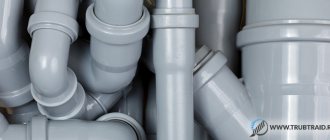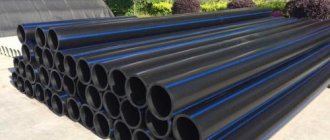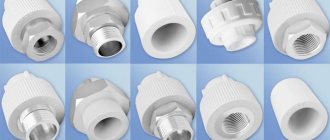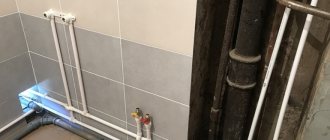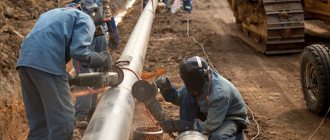Construction of a country house or major renovation of an apartment will not be complete without installing or updating communications. When choosing designs for water supply, heating or sewerage, along with other characteristics, it is important to know the service life of the pipes. Previously, all products of this type were produced exclusively from steel and cast iron and served for up to a hundred years. Today, products made of polypropylene and metal-plastic are extremely popular, which differ from metal structures in ease of installation, lightness, and environmental safety. However, the service life of communication systems made from such material is significantly shorter.
Service life of steel pipes
Steel products are used not only in everyday life, but also in many other areas of activity. They are used for the installation of irrigation systems, oil pipelines, gas and heating mains. Many of the older apartments have steel communications that still serve today.
For organizing heating systems, it is recommended to use products made of black steel, while galvanized products are more suitable for plumbing. To protect steel pipes from corrosion, which becomes the root cause of communications failure, manufacturers apply zinc coating inside and outside.
The service life of a steel riser or liner in a cold water supply system is 30 years, hot - 20 years.
Copper
The next metal on our list is copper.
Copper water supply: stylish and durable
How long can these metal hot water pipes last? There are no regulatory documents establishing specific service periods. Manufacturers promise a vague “50+” years.
In practice:
- The oldest copper water pipes have been in service for more than a century and are still in perfect condition;
- Copper does not degrade over time, is not subject to corrosion and is only afraid of significant mechanical stress: the metal is very plastic, and the pipe walls are only about a millimeter thick.
Destructive factors
As they say in the hero city of Odessa, “there are some”:
The service life of copper plumbing may be reduced if press fittings with rubber O-rings are used instead of soldering when installing it. Over 20-30 years, rubber loses its elasticity (primarily in hot water) and is capable of leaking;
Press fittings for copper pipes. The service life of the water supply is limited by the durability of the O-rings
Banal erosion can lead to destruction of the walls of copper pipes. At high flow rates, sand and other suspended matter rapidly destroy soft metal;
The coarse filter at the entrance to the house is capable of purifying water from sand and suspended matter.
Theoretically, water hammer and freezing of water in it can break a copper water supply. However, the water hammer must be truly extreme (the destructive pressure for copper pipes is 200 - 240 atmospheres), and defrosting must be repeated at least 5-6 times: the plasticity of copper allows it to withstand a slight change in diameter or length without destruction.
How long will cast iron pipes last?
Despite the widespread popularity of plastic and composite structures, when installing sewer lines, preference is still given to cast iron products. Such systems can operate without major repairs for 70 to 100 years, and with careful care and regular cleaning - even more than this period.
The service life of a cast iron structure is reduced only due to the joints, which become unusable after 5–7 years. Regular flushing of the pipeline to remove internal deposits will help increase service life, and if you have access to the external surface, then cleaning it.
If you do not monitor the condition of communications, the service life of cast iron products will be reduced by half.
Service life of plastic (polypropylene) pipes
Manufacturers of plastic pipes assure that such products can last up to 50 years. However, products made from polypropylene appeared relatively recently and the reliability of such statements has not yet been proven.
In order for the plastic structure to last as long as possible, certain operating conditions must be observed, the main ones being water pressure and temperature. The higher the load and hotter the water, the shorter the service life of polypropylene products. Moreover, it should be remembered that the temperature of the liquid in plastic structures should not exceed 95 ° C, otherwise the product will begin to deform and will not last even one year.
When arranging external pipelines, it is necessary to take into account the destructive effect of direct sunlight, as a result of which the plastic becomes fragile and extremely sensitive to deformation and mechanical shock.
Service life of metal-plastic pipes
Metal-plastic pipes are more reliable and stronger than plastic ones, since they have a multi-layer structure - there is a reinforcing layer of aluminum inside. This product is treated with a polyethylene coating on the outside and inside.
We recommend: Features of linoleum marking depending on the properties of the coating
Communications made of metal-plastic combine the positive properties of all other structures, so they are more durable. The service life of structures made from this durable material reaches 50 years.
The service life of a water supply system in residential buildings, consisting of metal-plastic pipes, depends on the quality of the water and the correct installation.
What is the best material to make sewer pipes from?
Two types of pipes are used to install a sewerage system:
- cast iron,
- plastic.
Cast iron structures will last more than 80 years, but they have their disadvantages, including high cost, heavy weight and an uneven internal surface, which leads to waste retention and clogging.
Plastic pipes have maximum throughput due to the fact that they have smooth walls. In such systems, blockages almost never occur.
What to consider when choosing heating pipes?
There are no universal pipes that would be equally suitable for installing a heating system in different rooms. When choosing pipes for your home or apartment, you need to consider the following factors:
- Water temperature and pressure. In individual systems, pressure is usually maintained at no more than 2-3 atmospheres, and in centralized systems - up to 16 atmospheres.
- External or hidden type of system.
- Possibility of installation without the involvement of specialists.
About 95% of all heating systems are installed on the basis of plastic pipes. Of course, classic types of pipe products made of steel, copper, and iron also have a right to exist, but they have many disadvantages, the main ones being high cost and complexity of installation.
The following types of pipes are used for heating in modern houses:
- Metal-plastic - used for underfloor heating systems. Since a metal-plastic pipe can delaminate from prolonged exposure to high temperatures, it is used for coolant having a temperature of no more than +40°C - +50°C.
- Polypropylene is an inexpensive, simple pipe that does not conduct heat well. It is used for self-installation of an external heating system, but not for heated floors.
- PEX is flexible, resistant to high temperatures and stress, and is an excellent conductor of heat. Excellent for organizing external and hidden heating systems. The homogeneity of the material prevents its delamination. Assembly is carried out manually using fittings.
PEX-EVOH is one of the latest developments that provides an oxygen barrier. Oxygen, which penetrates into the coolant through plastic in minute quantities, promotes the growth of bacteria. It has been noticed that over 20 years of operation of the heating system, so many microorganisms form in the pipes that they can completely clog the lumen. This does not happen in a pipe with an oxygen barrier.
A few more benefits
It is worth mentioning the lifespan of steel pipes in Stalin-built houses, where they are used in the heating system at a temperature not exceeding 50-60 degrees. Heating systems that are equipped with cast iron radiators can easily last for more than a century. Although they can’t even do it, they still serve. There are cases when such heating systems were built at the end of the 19th century and functioned perfectly until the mid-80s of the 20th century.
It is worth noting another good property of steel. It is difficult to overestimate - this is the lowest coefficient of thermal expansion among other pipes. So, for example, for copper it is 2 times greater, and for plastic it is 15-20 times greater. In simple terms, this is the stability of their sizes.
So, no other pipes should be hidden in the walls or floor, since they increase or decrease in size when the temperature changes (this is especially important if heating is being considered). And this already leads to a violation of the integrity of the coating in which they are mounted
Therefore, when using non-metallic pipes, compensating structures such as, for example, soft thermal insulation are used.
A steel pipe, like many metal pipes, is best suited for the construction of radiant (not to be confused with radiant) water heating systems. If we talk about disadvantages, the most important ones include a high level of corrosion, as well as damage of various types. All steel pipes used in heating rust very quickly and become clogged with various deposits. The best way to protect is to use galvanizing technology and laying pipes of larger diameter.
Perhaps the only and main disadvantage of using galvanizing is the impossibility of using antifreeze in this system, on which operation, that is, service life, depends. If we consider in more detail, zinc coating increases their resistance to corrosion, which can cause their service to deteriorate. This helps to extend the “life” and service life of metal structures by approximately several years.
What pipes should be installed for water supply?
Typically, metal, plastic and metal-plastic pipes are used to install a water supply system.
We recommend: How to remove old paint from a metal surface: 5 easy ways
Indoor plumbing is the distribution that carries water to plumbing fixtures and other equipment in the home. For each type of pipe product there is a value for the maximum water pressure that they can withstand. For example, in a house with a central water supply, the pressure ranges from 2.5 to 7.5 bar, and can sometimes rise to 10 bar. To prevent the pipeline from bursting, you need to focus on maximum indicators.
When choosing water pipes for installation inside a house or apartment, you must take into account not only the maximum pressure, but also the water temperature. Copper, brass, bronze, steel pipes can withstand high pressure - there are no restrictions on their use for water supply.
Metal-plastic water supply is perhaps the best option for a private home. They do not corrode, do not sag under their own weight, and will last for almost 30 years. Withstanding temperatures up to +95°C at a pressure of 10 atmospheres, the structure does not deform during a short-term temperature jump to +110°C and constant pressure.
Cink Steel
Thanks to its anti-corrosion coating, galvanizing should be more durable than black steel. How much?
We can find data about him in the same VSN 58-88:
Destructive factors
How and why can a galvanized metal pipe for water supply fail?
While working as a plumber, the author observed the only scenario for the appearance of fistulas on galvanized water pipes: they occurred at a welded joint. Strictly speaking, galvanized pipes cannot be welded “at all”: in the area of the seam the zinc burns out completely. You see, it evaporates already at 900 degrees, and steel melts at 1400-1500.
As a result, the owner of a galvanized water supply system mounted on welded joints receives a pipeline made of corrosion-resistant (albeit in some places) material, but at twice the price.
How to properly install galvanization with your own hands to ensure maximum service life of the water supply system?
Here are the instructions that plumbing equipment installers used in the 50-60s of the last century:
All connections are made only and exclusively on threads (cut by hand or on a lathe) using cast iron threaded fittings;
The connections are sealed with plumbing flax and the windings are impregnated with red lead.
Do galvanized water supply pipes become overgrown? Deposits and rust do not linger on their walls, but the formation of a water-impenetrable plug is still possible under certain circumstances. It goes like this:
- Debris accumulates in the water supply (usually cold) - sand, welding scale and rust flakes. A blockage is formed if the water supply taps are always opened only partially, and the speed of the water flow does not allow it to carry debris into the mixer and further into the sewer;
- Over time, the accumulation of debris is cemented with lime and iron oxides, gradually turning into a material with the strength of stone.
Actual service life
The author of the article must repent to the reader: he cannot name either the minimum or maximum service life of galvanized water supply. The fact is that he has never encountered a galvanized pipe that needed replacement due to natural wear and tear.
The lines and risers, which were opened after 50-70 years of operation, were invariably in impeccable condition and were no different from new ones.
Types of chimneys
The modern range of smoke exhaust pipes is pleasing to the eye. This includes expensive smoke structures made of ceramics (usually used for baths), and steel and thermoplastic products. However, stainless steel pipes are considered the most reliable today - they can withstand heating up to +600°C. Due to the perfect fit, the entire structure made of this material is sealed, so there is almost no soot and condensation formed here.
But ceramic products, on the contrary, are used quite rarely, since they have a considerable weight, which can only be supported by a massive stationary stove used to heat a residential building.
When building a summer house, a country house or carrying out renovations in an apartment, special attention must be paid to the arrangement of communication structures: water supply, gas pipeline, sewerage. For each type of communications, a certain type of pipe is suitable, differing in characteristics and service life.
Properties of polyethylene structures
The main advantage of polyethylene pipes is the high level of plasticity. Only these pipes can freeze along their entire length in winter and thaw in summer without losing their tightness.
A high ductility index ensures good seismic stability of the system.
Polyethylene water pipes are not afraid of any movements or shocks in the ground.
The disadvantages of this material include low heat resistance; a polyethylene pipe can only pump cold water, the temperature of which does not exceed 40 degrees Celsius.
